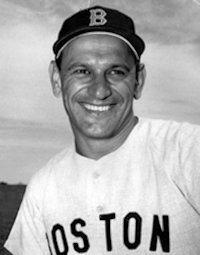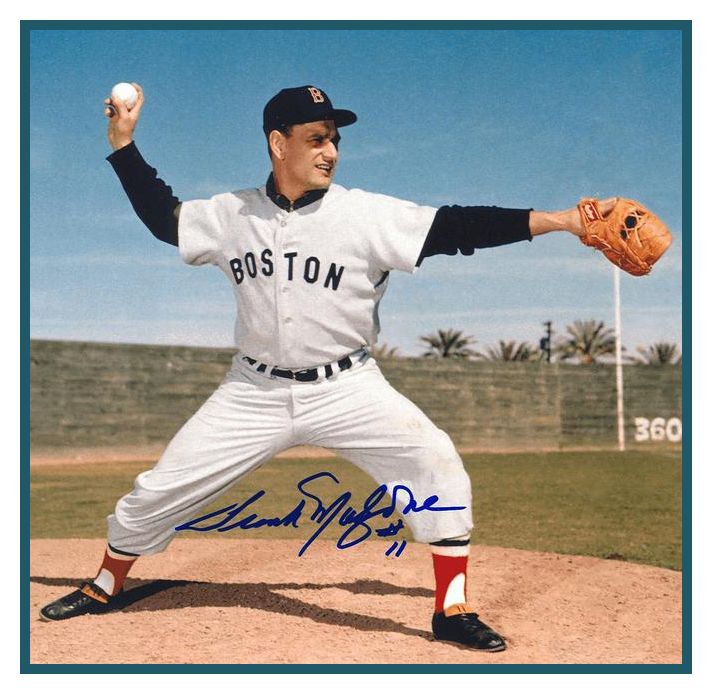|
“FENWAY'S BEST PLAYERS”  |
|||||
Born and raised in the Bronx, All-Star and Gold Glove third baseman by 2010 Frank Malzone had been a Red Sox fixture for more than 60 years, save for one season playing for the California Angels. Born on February 28, 1930, he was a Yankees fan growing up but was signed out of Samuel Gompers High School by Red Sox bird-dog scout Cy Phillips in 1947. His parents had to sign the agreement. The Red Sox paid him $175 per month as he put in his first season in professional ball in Delaware with the Milford Red Sox in the Class D Eastern Shore League, under manager Clayton Sheedy. He played in 120 games, with a .304 average that was second only to Norm Zauchin and Ray Jablonski. Frank first learned baseball by watching his older brother, Tony, and sister Mary play sandlot ball, for the Leland Cubs (they had an older sister Margaret, or Marge, as well). Tony played second base and Mary was the catcher, and they were charged with watching over their 9-year-old younger brother, Frankie. It was only in his last two years in high school that Frank played for the school team. He was studying to become an electrician, but he started thinking about playing baseball. A tryout for the New York Giants was discouraging. “You’re too small, better forget it” is what he was told. But he’d seen Phil Rizzuto play, and knew stature alone was no obstacle. Not one team scouted Malzone, but bird dog Cy Phillips spotted him. Phillips knew Red Sox farm director Specs Toporcer from playing sandlot ball in Central Park. Phillips wrote Specs several times, until Toporcer sent scout Charlie Neibergall to sign Malzone. In 1949, Frank climbed a rung up the organizational ladder to Class C, playing the full year with Eddie Popowski’s Oneonta Red Sox. At Oneonta, Frank improved his average to .329, leading the team. Malzone’s 178 hits ranked him tops in the Canadian-American League. He hit 26 doubles and 26 triples. He suffered a setback in 1950, appearing in only two games with the Class A Scranton Red Sox (manager Jack Burns). In the season’s second game, he broke his leg near the ankle sliding into second base (his foot was reportedly – in Bob Holbrook’s words – “turned completely around”) and was lost for the full campaign. Burns later told The Sporting News, “I didn’t think he’d ever play ball again. Malzone didn’t play again until 1951, but he played well for Burns at Scranton for most of the ‘51 season (he had skipped spring training because he’d been told he was going to be drafted.) Starting late, it took him a while to play his way into shape, but he hit .283 and played right up through his September 19 double play which closed out the team’s third win in the playoff finals. He’d been summoned to the United States Army. He spent all of 1952 and 1953 in military service. Like many ballplayers of those days, Malzone had the opportunity to hone his ball playing skills while in the service. During his initial induction interview at New Jersey’s Camp Kilburn, the sergeant asked, “How would you like to go to Hawaii for basic training?” Frank said he’d rather stay in the States. “Well, you’re going to Hawaii.” He was on his way toward Korea and the war. He had orders to ship out to the war zone, when a colonel saw he’d played minor-league baseball and changed his orders, to stay on the island at Fort Shafter. At first Frank worked as an M.P., then in a warehouse, eventually joining the Special Service, where Corporal Malzone played for the Fort Shafter Commandos. The team won 18 of its first 21 Hawaiian Armed Forces League games; Malzone starred in the 18th win with two doubles and a homer as the Commandos crushed the Pearl Harbor Marines, 14-1. No less than Ted Williams asked Joe Cronin about Malzone, having heard about him as Capt. Williams passed through Hawaii, heading home after his 39 combat missions in the Korean War. When Frank returned to organized ball, in Triple A with the 1954 Louisville Colonels, he’d missed three of the preceding four years. Manager Pinky Higgins worked him out at second base, too. “Malzone has a quick throw. He ought to be able to get the ball away from him fast on double plays.” Malzone hit .270 his first year in Triple A – playing third base. Frank’s first spring training with the parent club was in 1955. After Higgins’ success with Louisville, he became the big-league manager. He increased his average to .310, was named to the American Association All-Star Game, and became a mid-September call-up who debuted in major-league baseball on September 17th. Frank made the 1956 team out of spring training. Higgins was high on him. Malzone played through June 5, getting into 27 games (he drove in the seventh run in the 8-1 victory in his first game). He hit a couple of home runs, but come early June, he had hit only one single in his last 33 at-bats and was hitting .165. It seemed advisable to send him to San Francisco, but even that didn’t help at first. He played out the rest of the year on the West Coast, batting .296 for the Pacific Coast League’s Seals. He ended the season well, entering the last week riding an 18-game hitting streak and hitting a grand slam on September 7. After that, Frank returned to winter ball in Puerto Rico, playing for Ralph Houk and the San Juan Senators. Returning to 1957, Frank could no longer be denied. He made the Red Sox team for good, and was fortunate that Higgins stuck by him in the early going. By May 8, he was hitting an even .300 and opponents learned to respect him. By June 23, he was hitting .322 – better than any other major-league third baseman – and flashing the glove, too. On July 4, he was the first American Leaguer to reach 100 hits. Orioles third baseman George Kell, selected to start the All-Star Game, declared, “I don’t deserve it. … This Red Sox kid is great, really great. He should have gotten it.” American League manager Casey Stengel named Frank as a reserve, and he spelled Kell at third. Both players were 0-for-2 in the game. In his first full season, Frank Malzone was an All-Star. By season’s end, he ranked 10th among all American Leaguers with his .292 average. His hitting was productive; his 103 RBIs ranked third in the AL (in a three-way tie with teammate Jackie Jensen and Minnie Minoso). Because he had had 103 at-bats in 1956, he was ruled ineligible for Rookie of the Year voting – but still came in second (one maverick voter cast a ballot for him anyway, while the other 23 voted for Tony Kubek). The voting followed a month-long controversy over what the criteria should be for ROY. Malzone was voted as the top sophomore, so named on 166 of 182 ballots; Luis Aparicio was second, with 14 votes. For his part, Malzone just said he was happy to have made the grade in the major leagues. Malzone led the American League in total games, and led third basemen in chances, assists, and double plays. It was no surprise that he was named the major leagues’ Gold Glove winner at third base. Starting in 1958, each league awarded a Gold Glove – and Malzone won again in both 1958 and 1959. His goal for 1959 was to hit .300. He didn’t make it; in fact, he declined to .280, though he boosted his homers from the 15 he’d had each of his first two years up to 19 and bumped his RBI total up to 92. Another All-Star Game (a “defensive standout,” wrote The Sporting News) and another Gold Glove. He started out stronger, and was over .300 through almost all of May but then cooled off just a bit and was very consistent around .280 for the rest of the season. With Ted Williams on the way out, and Carl Yastrzemski not established yet, it was an in-between time for the Red Sox and there wasn’t the protection in the lineup that benefits a good hitter. In 1960, Malzone was almost the only right-hand hitter with any power. Only Vic Wertz, a left-handed hitter, had more RBIs than Malzone. In 1961, an ankle injury caused him to miss most of the first week of the season, but by year’s end his 87 RBIs were seven more than the next-closest Red Sox batter, rookie Yastrzemski. Frank led Yaz again in 1962, batting in one more run than Yaz’s 94 – but Yaz scored 99 to Malzone’s 74. Frank’s biggest play of the year may have been the eighth-inning foul ball he caught on June 26, saving Earl Wilson’s no-hitter, a backhanded grab right at the top of the Angels’ dugout. Malzone also hit 21 homers in 1962, a career high. A month later, Malzone was hurt in Yankee Stadium and missed three games, the first games he’d missed all season. Malzone made another run at .300 in 1963 – batting as high as .345 on July 1, before dipping in the final two months to .291. Playing for new manager Johnny Pesky, the “old pro,” he was now 33, and had been seen as the veteran player for a few years. One of his more thrilling contributions of the year was the three-run homer he hit in the top of the 15th inning against Detroit on June 11. He had missed out on the All-Star Game in both ‘61 and ‘62, but his hot start in 1963 – the best of his career – saw him named to the squad once again. The promising start he’d had in 1963 failed to hold up and the ball club plunged in the standings, finishing in seventh place in ‘63 and eighth place in 1964. Malzone hit .264 in 1964 and drove in what was at that point a career-low 56 runs. He did make the All-Star squad again, for the last time. In 1965, Malzone got less work, down to 400 plate appearances in 106 games. There was one stretch from May 13 to June 18 in which he failed to get an extra-base hit. His first home run of the year didn’t come until August 1. By early September, there was talk that it might be Malzone’s last year with the Red Sox – and Yaz spoke up, saying how much time Frank had put in working with possible heir-apparent Dalton Jones, helping Jones with his fielding – even though it might cost him his own job. For the season, Malzone hit just .239 with 34 RBIs. On November 19, 1965, the Red Sox gave Frank Malzone his unconditional release. General manager, Dick O’Connell gave Frank the choice of becoming a minor-league manager, a hitting instructor, or a scout. Malzone found they paid about the same, but scouting in the New England area afforded him the opportunity to be home more often. Frank Malzone was one of the inaugural class of inductees into the Red Sox Hall of Fame, in November 1995. He died on December 29, 2015 at his home in Needham, MA.
|
|||||

